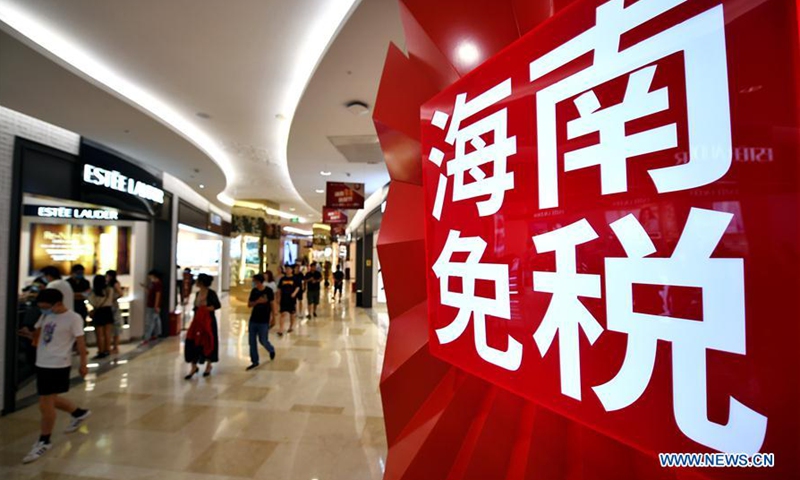Hainan raises duty-free shopping quota, expands commodities category to stimulate consumption, tourism
By GT staff reporters Source:Global Times Published: 2020/6/30 11:47:57

Customers shop at a duty-free shop in Haikou, capital of south China's Hainan Province, June 29, 2020. Hainan province will ease the limitations on duty-free shopping with the quota to be raised from 30,000 yuan (about 4,230 U.S. dollars) to 100,000 yuan per person per year, and provide more categories of duty-free commodities. The policy will come into effect on July 1. (Xinhua/Guo Cheng)
China's tax-free related stocks opened higher on Tuesday morning, with some rising by the daily limit of 10 percent. Investors were cheered overnight by a new policy that expands the per capita quota for offshore duty-free shopping in South China's Hainan Province from a previous 30,000 yuan ($4,239) to 100,000 yuan a year.
Stocks including Wangfujing and Caissa rose by the daily 10 percent limit on Tuesday. As of 11 am on Tuesday, HNA Infrastructure and China Duty Free have soared by 9 percent and 8.9 percent, respectively.
The new rule, effective from Wednesday, was jointly released by the Ministry of Finance, General Administration of Chinese Customs and China's State Taxation Administration on Monday. It also newly includes seven new categories of duty-free commodities such as the consumer-favored electronics products to further stimulate consumption amid pandemic impact.
Most of the common products favored by Chinese consumers are basically included in the tax exemption list, categories of duty-free commodities have been raised to 45 from the previous 38. Watches, perfumes, cosmetics, infant formula milk powder, tablet computers, wearable devices, mobile phones, video game consoles and alcohol, are all included in the list, read the announcement.
Nevertheless, the new rule still imposes a limit on the number of single purchases of three types of products - cosmetics, mobile phones, and alcoholic products. Specifically, the purchase of cosmetics is limited to 30 pieces per person, the purchase of mobile phones is limited to 4 pieces per person, and the purchase of alcoholic products should not exceed 1,500 milliliters.
The new rule applies to four duty-free stores in Hainan, including two in the capital city of Haikou, one in Sanya, and another one in Boao, according to media reports.
A boost for domestic consumption
The new rule will be the most attractive policy for Hainan tourism, and an effective measure to stimulate domestic travel and consumption to shore up virus-hit economy. This is particularly insightful when outbound tourism - which used to be the major way for Chinese people to buy imported products, was not available in a certain period of time, industry insiders said.
"The 100,000 yuan limit is a huge increase, and I will definitely find time to travel to the province to buy more duty free products," Li Sha, a Beijing-based white collar worker, told the Global Times on Monday, describing the new rule as "timely and very attractive."
"People will not bother travelling overseas for a 'bargain' in luxury products," Li said.
Huang Qian, a Beijing-based veteran industry insider, told the Global Times that the new rule also represents China's broad efforts to lift domestic consumption to offset the fallout of the global pandemic, which has cast a shadow over the country's foreign trade prospects.
Wangfujing, one of China's largest retail groups specializing in department stores, said in an exchange filing on June 10 that it had been granted a duty-free license from the Ministry of Finance. The company now operates over 50 stores in 33 cities across China.
Sales of duty-free products in Hainan could become one of the main drives for China's social retail sales recovery, industry insiders noted. In May, sales of duty-free products in Hainan grew 147.9 percent year-on-year to 1.98 billion yuan, partly thanks to the May Day holidays and a number of promotional campaigns.
Since China began trialing the tax-free shopping policy in the province in April 2011,16.31 million purchases with a total sales of 53.8 billion yuan has been made as of the end of 2019, customs data showed.
From 2011-19, annual duty-free sales in Hainan climbed from 986 million yuan to 13.6 billion yuan, relevant data showed. The number of consumers also rose from 483,600 in 2011 to 3.84 million in 2019.
This policy adjustment will greatly improve consumers' shopping experience and promote the construction of Hainan into an international tourism and consumer center, and enhance the confidence of all sectors in the construction of Hainan Free Trade Port, the announcement read.
Shen Xiaoming, governor of Hainan, said at a press briefing in early June that Hainan will rise to be an important destination for shopping and travel after improvements to its offshore duty-free policy. "We hope the island will become a paradise for vacations and shopping," Liang noted.
The new rule is also in line with the a master plan for the Hainan free trade port, aiming to build the southern island province into a globally-influential high-level free trade port by the middle of the century.
A free trade port system focusing on trade and investment liberalization and facilitation will be "basically established" in Hainan by 2025 and become "more mature" by 2035, according to the plan jointly issued by the Central Committee of the Communist Party of China (CPC) and the State Council on June 1, according to a report from the Xinhua News Agency.
Global Times